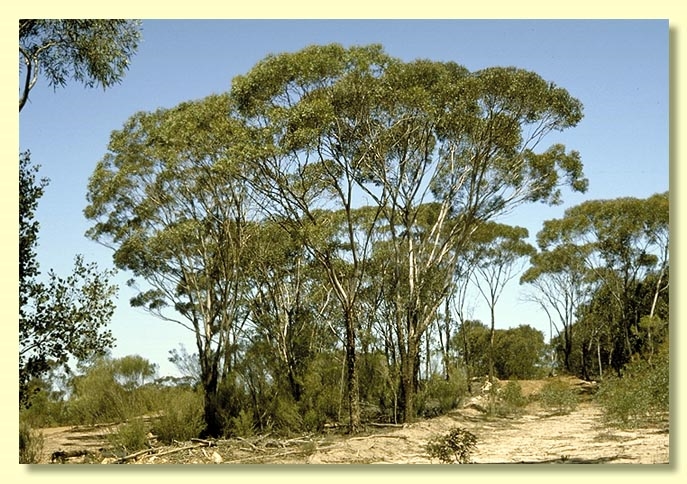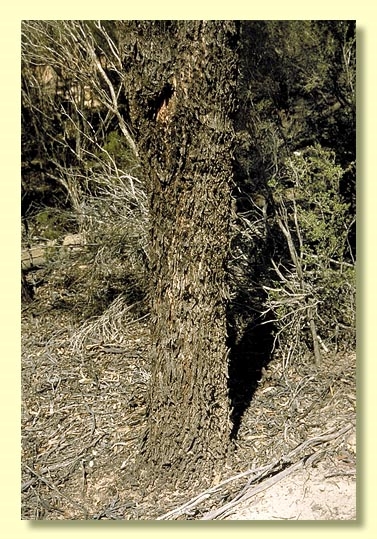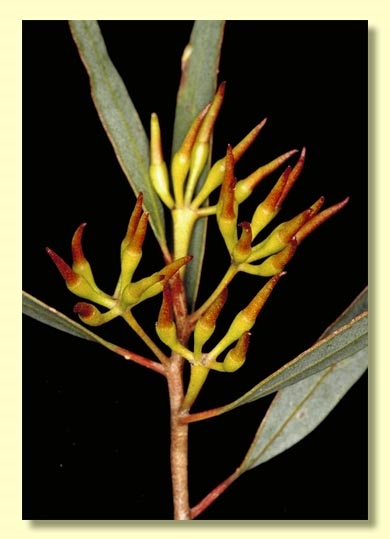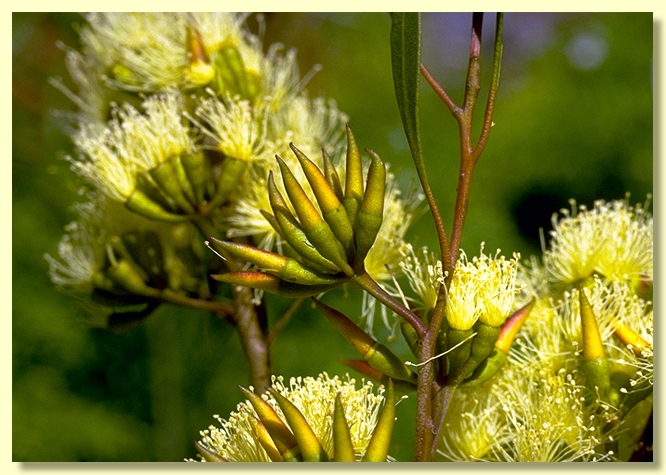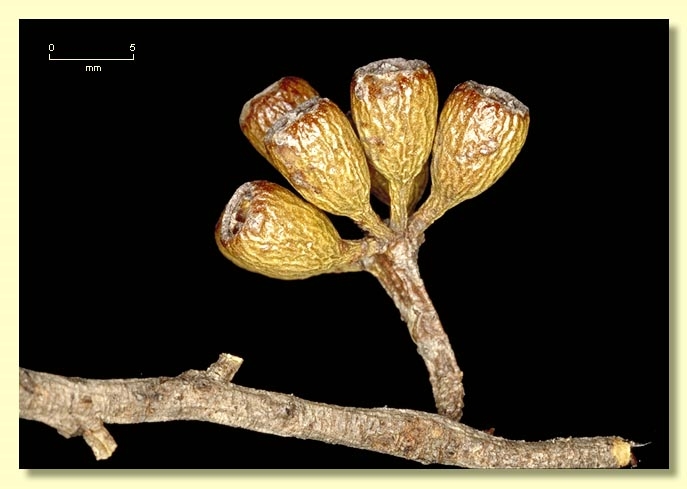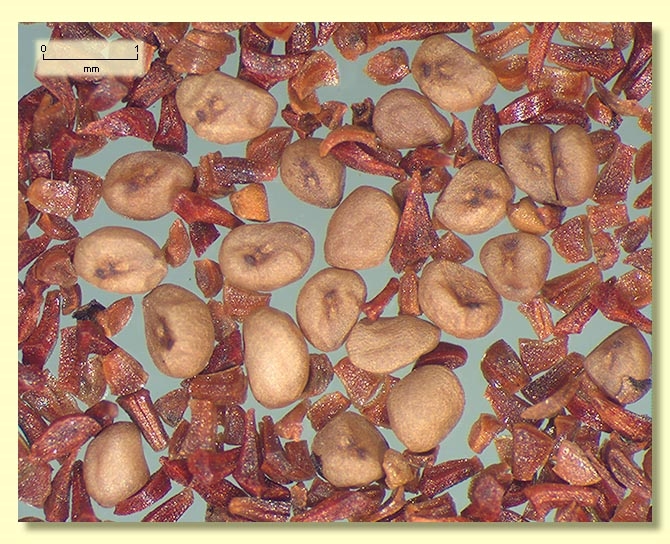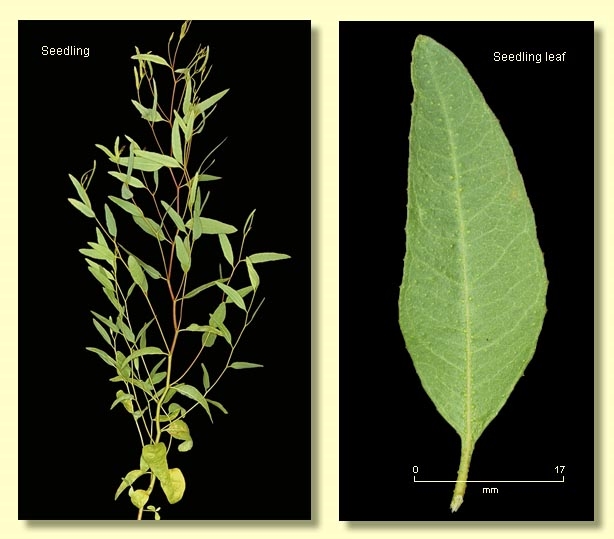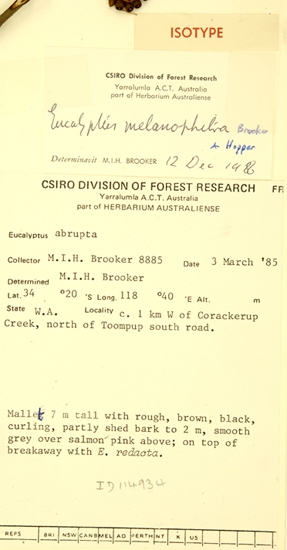Eucalyptus | Symphyomyrtus | Bisectae | Glandulosae | Levispermae | Cubiformes
Euclid - Online edition
Eucalyptus melanophitra
Bark rough, flaky and grey over all or part of trunk, smooth above grey to pale grey over salmon pink.
Branchlets have oil glands in the pith.
Juvenile growth (coppice or field seedlings to 50 cm): not seen.
Adult leaves alternate, petioles 0.5–1.3 cm long; blade narrowly lanceolate, (4.5)5.8–9.5 cm long, (0.7)0.9–1.5 cm wide, base tapering to petiole, margin entire, apex pointed, concolorous, dull, green to greenish blue, side-veins greater than 45° to midrib, reticulation moderate to dense, intramarginal vein remote from margin, oil glands island and intersectional.
Inflorescence axillary unbranched, peduncles widen apically, 0.7–1.5 cm long, buds ?9 or 11, pedicellate (pedicels 0.3 cm long). Mature buds fusiform (1.3–1.5 cm long, 0.3 cm wide), often hooked apically, scar present, operculum conical, twice the length of the hypanthium about equal to it at the join or only slightly narrower, few outer stamens erect, most stamens variably deflexed, anthers cuboid, versatile, dorsifixed, dehiscing by longitudinal slits, style long and straight, stigma rounded, locules 3(4), the placentae each with 4 vertical rows of ovules. Flowers pale yellow.
Fruit pedicellate (pedicels 0.2–0.3 cm long), cylindrical to barrel-shaped, 0.6–0.7 cm long, 0.4–0.5 cm wide, disc descending vertically, valves 3(4), about rim level.
Seeds pale brown to straw-coloured, 0.7–1.5 mm diameter, sub-spherical, surface smooth, hilum ventral/terminal.
Cultivated seedlings (measured at node 10): cotyledons Y-shaped (bisected); stems rounded in cross-section, smooth or warty; leaves shortly petiolate, opposite for ca 3 or 4 nodes then alternate, lanceolate, 6–8.5 cm long, 1–2 cm wide, green, dull.
Flowering has been recorded in February, March and April.
A mallet endemic to Western Australia, of very restricted distribution north-east of Albany in the Pallinup River – Corackerup Creek – Boxwood Hill areas, on lateritic rises. The bark is dark, flaky, rough over the whole trunk or on the base only. The adult leaves are dull, green to greenish blue.
Eucalyptus melanophitra belongs to Eucalyptus subgenus Symphyomyrtus section Bisectae subsection Glandulosae because the cotyledons are bisected, buds have an operculum scar and the branchlets have oil glands in the pith. Within this subsection E. melanophitra is one of a group of 14 species that form series Levispermae subseries Cubiformes, characterised by having smooth almost cuboid to sub-spherical seed (not spherical), flattened peduncles that widen apically and buds that are narrowly fusiform with some stamens erect and others variably deflexed.
The combination of habitat, habit, bark and adult leaf characters plus the small fusiform buds to ca 1.5 cm long distinguish E. melanophitra from others growing in the area. The only related species with mallet habit in this general area is E. praetermissa, which has scant loose grey rough bark or is entirely smooth-barked, and has dull green adult leaves slightly larger than those of E. melanophitra. Buds and fruit of the two species are similar. E. praetermissa has a very restricted distribution, being only found near Beaufort Inlet, west of Bremer Bay, and in the Fitzgerald River National Park. Another closely related and green-leaved species in the general area where E. melanophitra occurs is the mallet E. clivicola which differs in having smooth bark, glossy green adult leaves and longer buds.

